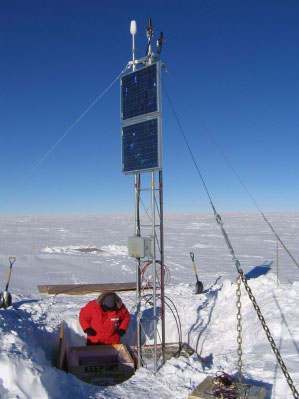National Science Foundation awards Space@VT $2 million to improve space weather understanding

Members of Virginia Tech's Space@VT research group are receiving a $2 million grant from the National Science Foundation (NSF) to build a chain of space weather instrument stations in Antarctica.
Space weather affects a variety of everyday consumer technologies including GPS devices, satellites for television reception, and cellular phones. Also, the understanding of space weather is critical to space programs.
For example, “satellites experience the disruptive effects of energetic charged particles and electrical charging across the satellite structure during various weather conditions. Astronauts are vulnerable to energetic radiation that may occur at space station altitudes. Navigation signals from global positioning satellites are affected by irregularities in the ionosphere that develop under some conditions, and massive disruption in electric power distribution systems can be triggered by geomagnetic storms,” explained Robert Clauer, professor of electrical and computer engineering at Virginia Tech.
Clauer is leading the team of researchers who include: Joseph Baker, assistant professor of electrical and computer engineering; Tamal Bose, professor of electrical and computer engineering; Brent Ledvina of Coherent Navigation, who also continues to hold an adjunct assistant professor of electrical and computer engineering position; and Majeid Manteghi, assistant professor of electrical and computer engineering. Bose is also the associate director of Wireless@Virginia Tech, a second Virginia Tech research group that is acting as a collaborator on this project.
The northern hemisphere is already well-instrumented as a number of stations currently exist in the Arctic, including an array in Greenland. But due primarily to the “extreme Antarctic climate and lack of manned facilities with the necessary infrastructure to support facilities, the southern polar region is not,” Clauer said.
Data from the southern magnetic field is weaker than the northern magnetic polar field because its “magnetic dipole is offset from the center of the earth and tilted,” Clauer, an expert in atmospheric sciences, explained.
One of the most spectacular manifestations of the dynamic sun-Earth environment or space weather is the aurora borealis in the northern hemisphere and aurora austrialis in the southern polar regions. “Since the space age, we now understand these phenomena to be specifically related to the processes of the electric and plasma dynamic environment that exists around the Earth, and these processes result from interactions between the solar wind and the Earth’s magnetosphere,” Clauer added.
Today, the science of space plasma physics has matured, but the goal remains for scientists and engineers to accurately predict the properties of space weather, and this is also the goal of the National Space Weather Program. Space weather refers to the conditions on the sun and in the solar wind, magnetosphere, ionosphere, and thermosphere that can influence the reliability of space borne and ground-based technology or which can endanger human life or health.
Clauer’s office is physically located at the National Institute of Aerospace (NIA), a consortium of universities established in 2002 to develop excellence in research and education in a spectrum of aerospace related areas of study, including space science. The NIA teams with NASA Langley Research Center in Hampton, Va., to conduct some of the nation’s most advanced aerospace and atmospheric research.
Earlier this year, members of the Space@VT group received a $6 million grant to build radar units. J. Michael Ruohoniemi, electrical and computer engineering associate professor, is leading this effort of which nearly $2 million of the award went to Virginia Tech and Space@VT, directed by Wayne Scales, also of electrical and computer engineering. Other participants in the grant, also from the NSF, are Dartmouth College, University of Alaska at Fairbanks, and the Johns Hopkins University Applied Physics Laboratory (JHU/APL).
These new radar units will complement the Super Dual Auroral Radar Network –– providing an acronym with a humorous touch, SuperDARN. This network is an international collaboration with support provided by the funding agencies of more than a dozen countries. The radars combine to give extensive views of the upper atmosphere in both the Arctic and Antarctic regions. The new radars will become part of a continuous chain of coverage that extends from Europe to eastern Asia.
Listen to the related podcast. (Length: 0:49)



.jpg.transform/m-medium/image.jpg)
